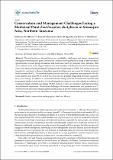| dc.description.abstract | The information on the medicinal use, availability, challenges, and future conservation strategies for the medicinal plant Zanthoxylum chalybeum were gathered by using a semi-structured questionnaire, focused group discussions, and field observations in Simanjiro Area, Tanzania. Data were collected from local village members who were familiar with the tree and the key informants. Data were analyzed using Statistical Package for the Social Sciences (SPSS). The extent of use was found to be very high, with more than three-quarters of harvested parts used for treating women’s health system (86.4%). The most used plant parts for medicinal purposes were reported to be the roots and the stem bark (90.3% and 81.6%, respectively), possibly suggesting mortality caused by heavy harvesting. In addition to unsustainable harvesting methods, minimal and unpredictable propagation methods were the key factors affecting the recruitment rate, with perhaps an addition of continued climate and land-use change (93.2%), indicative of low precipitation and high agriculture and settlement expansions. Given these challenges, the future conservation and persistence of Z. chalybeum looks uncertain, which requires such measures as the provision of education and awareness and ensuring proper land-use plans that encompass active recruitment of the species in these areas | en_US |

